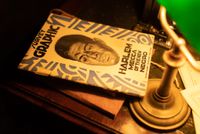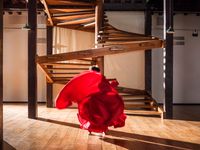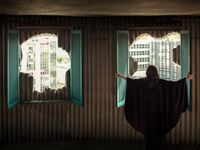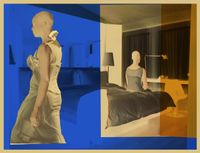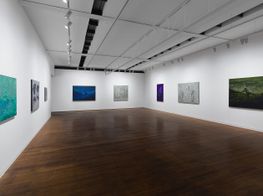Isaac Julien
Image: © Graeme Robertson

Image: © Graeme Robertson
Students of the School of the Arts in Singapore (SOTA) recently watched in reverent silence as British artist and filmmaker Isaac Julien played clips from his 50-minute film, Ten Thousand Waves (2010).
As Julien explained, Ten Thousand Waves was inspired by the Morecambe Bay tragedy of 2004, in which 23 Chinese cockle-pickers died on a flooded sandbank off the coast of northwest England.
Combining slices of real-life footage with drifting images of a mythical goddess and scenes of contemporary and historical China, the film reflects the artist's ability to blend fractured narratives into poetic masterpieces.
Most recently in 2014, the video was shown at MoMA in New York as an immersive film installation projected onto nine double-sided floating screens. The careful positioning of the screens choreographing the audience's movement through the installation—a reflection of the artist's long-term interrogation of global migration.
Organised as part of the Centre for Contemporary Art Singapore's (CCA) public programme, the presentation to students at SOTA took place alongside the recent exhibition Theatrical Fields (2014), which examined the use of theatricality in performance, film, and video, and included Julien's film, Vagabondia (2000).
Set within the extraordinary confines of Sir John Soane's Museum in London, Vagabondia is one of the films for which Julien was nominated for the Turner Prize in 2001 (the other was The Long Road to Mazatlán, 1990).
The CCA also screened Playtime (2014), which focuses on the complex subject of financial capital via three chapters and geographies, and the interconnected stories of those affected by the financial crisis of 2008. In both films, Julian draws upon and incorporates different artistic disciplines—theatre, but also music, painting, sculpture, and dance.
In this interview, the artist discusses the diverse influences underlying his work, Isaac Julien: RIOT (the book co-published by MoMA earlier this year), Sankofa Film and Video, and past films and future projects. Finally, he talks about the students of SOTA, their future, and the importance of artistic autonomy.
ADCould you tell me about your early influences? What led you to start working in film?
IJI started taking photographs very early on, and something that was interesting to me from the beginning was working with the mechanics and apparatus of the camera. Another significant thing about those early days was the milieu I was surrounded by: artists and activists like Astrid Proll—an early member of the Baader-Meinhof group—and a young woman called Noreen MacDowell.
Noreen MacDowell made films and I remember going to a screening of a film about Mozambique and thinking: 'Wow, is this really something allowed?' The work was an informative political documentary and I was struck very much by that.
There were other artistic groupings in East London who were very influential, such as Camerawork. They were an organisation that made photographic exhibitions and were very much committed to East End communities and cultural collectives.
They would have exhibitions that were about social and political issues that these communities faced, like policing, for example. They were addressing issues that I felt were affecting my life personally. These artists and what they were producing at that time made me want to make work myself.
ADYou originally studied both painting and fine art film at Saint Martin's School of Art, graduating in 1984. Was there ever a point where you thought you would be a painter, rather than a filmmaker?
IJBetween the ages of 19 and 20, I did a pre-foundation course—a two-year course before I did my degree course. I chose painting as a specialisation because it was interesting to me—it was truly creative and at the time it was something I knew I had the technique and skill to do.
In fact, when I started at Saint Martin's School of Art, my studio where I would paint was visited by the artist Peter Doig. To this day, we remain good friends. At one time, we were actually both working on making linocut prints, which we would often show to one another.
To supplement our art school education, we both had jobs working as dressers in major London theatres—he worked at the Royal Opera House and I worked on a number of musicals, including Evita and at the Prince Edward Theatre. My early linocut prints were often connected to me working as a dresser. There was an exchange around painting that influenced this too.
In the Playtime sequence that stars James Franco, there was an art exhibition that featured in the film entitled Cinematic Visions: Painting at the Edge of Reality. I co-curated that exhibition with James at Victoria Miro Gallery in London. That exhibition wasn't actually about cinema, it was about painting—about painters' reactions to cinematic expression. So I have always had a strong commitment to painting.
ADHow would you define the relationship between your film work and painting?
IJWorks like Vagabondia are another example that demonstrates my connection to painting through filmic work. There are aspects of the pictorial composition that are very relevant to the form of painting— I think about colour and texture.
For example, the red dress and the way that cloak hovers across the carpet in unison with the installation of the piece—it requires the red framing and red carpet. The frame has a bevel on it like the frame of a painting.
ADThe book, Isaac Julien: RIOT, was co-published with MoMA in conjunction with the presentation of Ten Thousand Waves at MoMA. RIOT must have presented an exceptional opportunity to reflect back on your life and your work. Was there anything in particular that you took away from that experience that may impact your work going forward?
IJIt was a project that was a result of collaborating with my studio and with MoMA, and drew from my archive, which was really fantastic. One of the important aspects about working on this publication was thinking about how I might be able to work with the archive, and how that eventually might become part of an exhibition. In a way that project was like a retrospective, but in the form of a printed publication.
In retrospect, there is also the idea about 'bricolage' and different things coming into contact with one another that result in many meanings within the context of ideologically varied cultural and political movements.
There is an exhibition that will open at De Pont Museum in Tilburg, Netherlands in January 2015, which is entitled Riot. We are showing several works from the last three decades drawing on some of the thematics and histories in the RIOT publication. It is an exceptional opportunity to use this publication to now make an exhibition. What I would really like to do is also to make a work that emanates from the archive in some sort of way.
ADThe title Isaac Julien: RIOT references the impact the riots in East London of 1981 had upon you, but is there more that you wanted to convey by using the word 'riot' in the title?
IJYes. It references a number of things and different points in my own life that are important to the work that I have produced. In retrospect, there is also the idea about 'bricolage' and different things coming into contact with one another that result in many meanings within the context of ideologically varied cultural and political movements. So the exciting thing about the riots that took place in London was that they had such strong political ramifications and they also catalysed artistically minded people to get together and react.
For example a film like Territories—which I produced in 1984 and is currently showing at the Centre Pompidou in Paris as part of an important and extensive exhibition entitled A History. Art, architecture and design of the 1980s to today—is a work that utilises particular techniques that have a 'bricolage' approach of bringing different forms and ways of producing images into one work. It is also a piece that was directly generated from that particular time and place of the London riots.
I am always interested in the type of aesthetics that get produced from a particular situation or happening in my own artwork as well as how people get together to make work—interesting works—and then go on to make other kinds of imagery. Because of those riots, there was a certain sensitivity in British artistic content, which in a way is quite opposite to many sentiments now in the country.
I am largely referring to sensitivity around questions of identity and race. Lord Scarman's report on Britain was an indication of the fact that at that time there were many voices within the population that were disenfranchised and did not have access to British institutions. You don't get that sentiment now as perhaps some artists feel that it is no longer relevant or in fact it is 'done'.
That moment in history produced certain encounters and dialogues that were the beginning of other things. Indeed you can see the effects of that in the visual arts today—Okwui Enwezor doing Documenta 11 and then going on to curate the Venice Biennale next year; in London, Frieze Art Fair 2014 which showed several African American artists and it seemed rather 'normal' to do so (artists like Wangechi Mutu and Glenn Ligon).
There was also the African art fair at Somerset House; these activities have now become part of the normal fabric of cultural and institutional life. And this is something that has a trajectory that can be traced back to the early 1980s.
ADSankofa Film and Video, which emerged in the period of the riots, arose out of that desire to provide a voice for black filmmakers?
IJAbsolutely.
ADIn a talk you did for the Tate, you said that without the hard years of struggling with Sankofa to make films, you wouldn't be here. What did you mean by this?
IJI feel that when we had initially left art school, Sankofa presented a way in which we were able to group together and contest various institutions for recognition. Interventions became something we could then pursue collectively. There was also the opportunity to have conversations that were really informative and directional. So Sankofa gave us the chance to come together and was the motor drive that gave us the ability to do things independently in the future: a solid foundation to spring board from.
I want to make a work that may have intellectual ideas that are embedded in cultural and artistic theory such as the work that you mention, but I also want to transcend them.
That particular moment had certain leaders, people like the revered Stuart Hall, who were pivotal in creating a space for critical thinking and for producing art. There were spaces and people who were indifferent and not as supportive and so you needed to force the hand to a certain degree. Being in Sankofa Film allowed you to make such interventions and to be really active in creating change and raising important issues.
ADAround the time you were involved in Sankofa, you created the pivotal film, Looking for Langston. I understand you wanted the film to be accessible to a wide audience, but at the same time the film is heavy with references to theory: Derrida's theory of deconstruction, Roland Barthes theories, and theories of the gaze. Tell me about the challenge of striking a balance between theory and the wider accessibility of your work?
IJThere is a translation that I am always interested in making. I want to make a work that may have intellectual ideas that are embedded in cultural and artistic theory such as the work that you mention, but I also want to transcend them. And transcending those ideas means to try and grapple with the possibility of the work being seen by as wide an audience as possible, but without trying to make theory reductive and to simplify it in any way. The challenge is to make a work that brings spectators to see it and speaks to an audience, and at the same time gets one to think about the issues the work raises. It is a slippery activity but a rewarding artistic endeavour. It is always a challenge.
I think in a work like Looking for Langston, it is beautiful enough to attract a wide audience but at the same time it retains its integrity in terms of its political and cultural ideas. Of course it is a work about black gay desire and there had not been many works about that subject matter. So it took a long time to research for and make a work like that—a work that for me would feel successful in terms of communicating those themes.
ADIn relation to Playtime, you have previously mentioned the challenge of visualising the concept of 'capital'. Do you feel in the end, you were able to successfully do this?
IJA work like Playtime is a challenging work and perhaps it is too early to say if it succeeded in doing what I wanted it to do, which is to transmit certain ideas and impact an audience enough for them to leave and still think about the issues the piece has raised.
When we showed the work at Victoria Miro Gallery in London, it had a huge number of people who came to see it—around 6000 visitors in total. The numbers were more like museum numbers. We are showing the piece not only in Singapore, but also it will premiere in Manila, Philippines at the Museum of Contemporary Art and Design. The film will have a particular interest and impact in the Manila community, as one of the main actors is the celebrated Filipino actress Mercedes Cabral.
ADThe character Mercedes Cabral plays is based on your own house worker?
IJYes, that's right. She is also coming to Manila with me as she is from the Philippines and has always wanted to meet Mercedes Cabral, the actress who tells her incredibly moving story. It will be an interesting encounter as this is rather an unusual thing to take place in the Filipino context. As we know, there are rather defined divisions in society in the Philippines. It isn't unusual there to have maids, as in several other places of course, but this class system is very prevalent there.
It is also important if you make a work that it reflects on your own context. In Playtime, I was self-reflexive and not trying to pretend that I am above the subject because I am always implicated in it.
ADMovement, dance and rhythm appear to have always been important in your films. Can we please discuss this?
IJThe choreographic element of my works is predicated on the idea of an annotational structure like in a musical score. Questions of movement and rhythm and how you construct narration are closely connected to these patterns of dance choreography.
In Vagabondia, the dancer is a trickster figure inhabiting a unique architectural and cultural space—Sir John Soane Museum in London. He creates an unusual relationship with the collection exhibited by transgressing a space where he wouldn't ordinarily be, and by moving in such a way that is completely unlike how one tends to move through a museum or art institution.
I have also used dance as a metaphor for the movement or migration of people from one part of the globe to another, for example in Western Union: Small Boats. In this piece, I was attempting to translate the voyages that people try to make from North Africa to the Mediterranean, but through choreographic expression.
In a work like Ten Thousand Waves, it is choreographic in terms of how the screens are arranged and the movement created by editing the film so the that the narration actually moves from one screen to the other.
In the instance of Maggie Cheung flying in one sequence, the sequence appears like a ballet of her movement as she glides from screen to screen. Many of these aspects were drawn from my interest in dance, movement, and music in my early years in London.
ADWhat are the next projects you are working on?
IJThere are several projects that I want to do. I have travelled to Brazil extensively to work on several of my own and exhibitions but also for research and I have become very interested in the work of Lina Bo Bardi. When I was in São Paulo fairly recently, I went to several Lina Bo Bardi exhibitions: one at SESC Pompéia and the other at Museu da Casa Brasileira. These were fantastic archival exhibitions of her work and her practice. The project that I want to make about Lina Bo Bardi is a little bit different though.
Lina Bo Bardi was a highly important woman architect who died in the nineties and was at the forefront of modernist Brazilian architecture. Born in Italy, she moved to Brazil post war and built prolific structures: huge buildings like the São Paulo Museum of Art. She is also very politically interesting. She was a Marxist that came from a bourgeois background: a complex character. I am interested in developing this history into an artwork.
There are two other smaller projects that I want to make, which perhaps won't be large multiscreen installations such as Ten Thousand Waves and Playtime. Vagabondia after all is a six-minute work and demonstrates that artists don't need to produce only large-scale projects for them to be significant or poignant.
ADYou have just completed lectures at the School of the Arts (SOTA) in Singapore. What advice did you give to the students?
IJThe SOTA students are some of the smartest young art students I have ever met. They are very, very impressive. To see the scope of their projects and the intellectual rigor that they apply and to think they are only 16 or 17 years of age is astounding.
The fact that they take such an interest in my work and attend exhibitions like Theatrical Fields at the Centre for Contemporary Art where I was recently showing Vagabondia shows the commitment and passion of these young people to art and to film. It is astonishing. They want to be artists, but there is no doubt that they will face challenges in their current context. While we know that there are numerous art fairs and fantastic initiatives, such as CCA in Singapore, there can still be a lack of complete autonomy for art and artists.
It will be interesting to watch this generation in this environment making work. They are the future and they will want to create conditions that allow for a more liberal approach to the arts here; a liberal approach to art making that matches the interest in the market and meets the different desires to create an art presence. They are going to make artworks that create an impact and that astonish: there is no doubt about that. —[O]


/22e8d662-b370-453e-a648-431fa373562f650457_400_0.jpg)

/78bbbd83-4fca-401c-9540-a20d83f136dd650433_400_0.jpg)
/Installation-view-of-Once-Again-Statues-Never-Die-Barnes-Foundation-2022-Photo-Henrik-Kam_400_0.jpg)


/Isaac-Julien-The-Lady-of-the-Lake-Lessons-of-the-Hour-2019-c-Isaac-Julien_400_0.jpg)
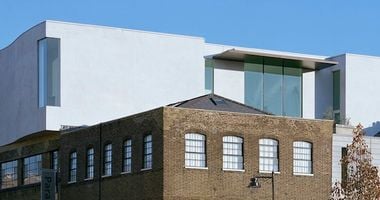
/Isaac-Julien-O-que-e-um-museu-Lina-Bo-Bardi-A-Marvellous-2019-c-Isaac-Julien_400_0.jpg)
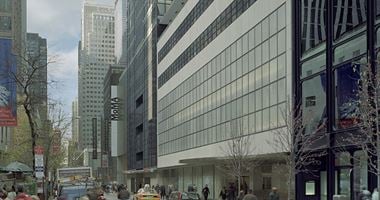
/Isaac-Julien-Pas-de-Deux-with-Roses-Looking-for-Langston-Vintage-Series-1989-2016-c-Isaac-Julien_400_0.jpg)

/Insights2020Isaac-Julien-Lina-Bo-Bardiisaac-julien12000_400_0.jpg)
/Isaac-Julien-In-the-Life-lolaus-Once-Again-Statues-Never-Die-2022-c-Isaac-Julien_400_0.jpg)


/ee2addef-7416-4bf4-a414-2ff4989c8b401300898_400_0.jpg)
/Statues-Never-Die306CU0A7765Henrik-Kam-2022-High-Res-JPEG-min-300dpi14400_400_0.jpg)
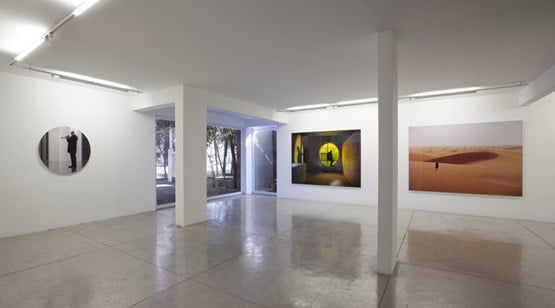
/7067712a-1110-4fcd-96b6-c9253428f1a6650433_400_0.jpg)
/25761e17-dc0b-47a1-9bce-615b814b1011650433_400_0.jpg)
/Isaac-Julien-Mazu-Silence-Ten-Thousand-Waves-2010-c-Isaac-Julien_400_0.jpg)
/Screenshot-2023-04-11-at-181835_400_0.jpg)
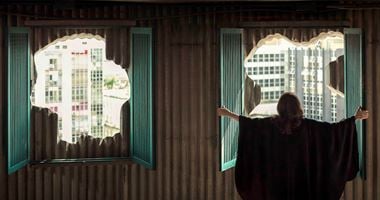
/Insights2020Isaac-Julien-Lina-Bo-Bardi2019Isaac-JulienVMG-Wharf-Road312000_400_0.jpg)


